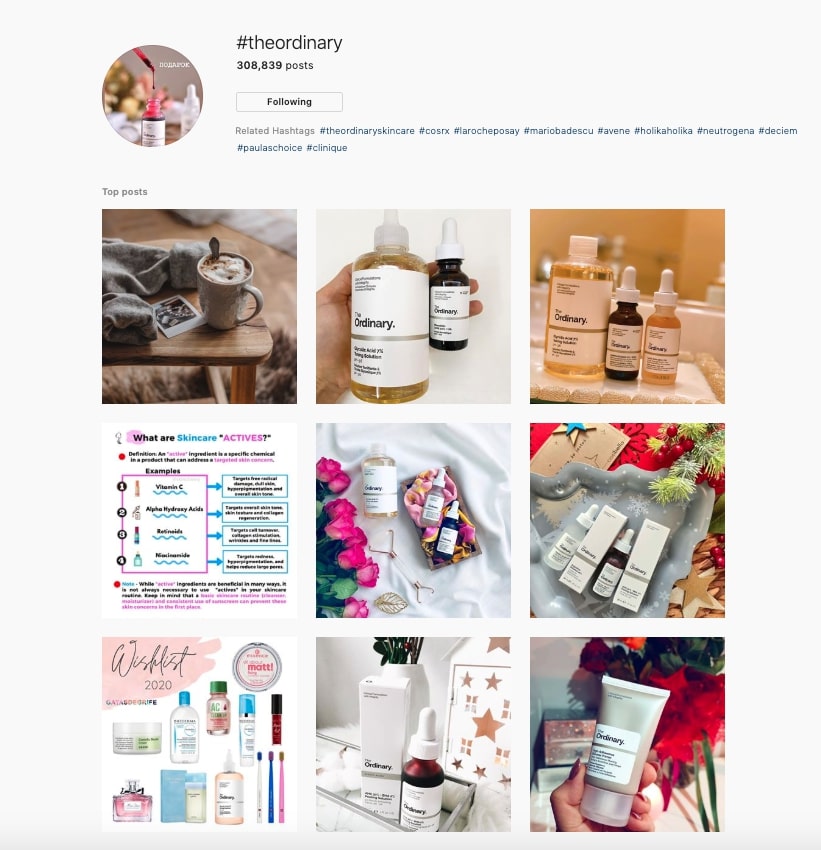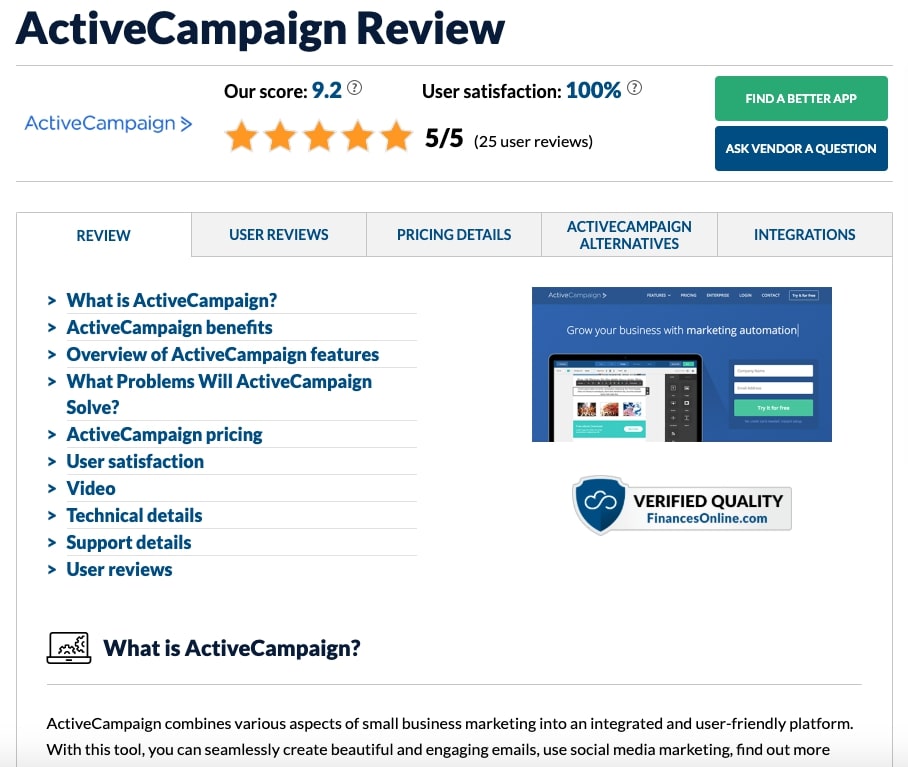
updated 6/20/2022 ⎮ 42 min read ⎮ Digital marketing
Customer reviews are the personal recommendations of today.
Get more and better
customer reviews
and give your small business a boost by focusing on the customer
experience in your digital marketing strategy.
What are customer reviews?
Customer reviews are pieces of feedback that customers can provide a business with after
their purchase to share their customer experience with others.
Customer reviews can be public or private and can be collected by the business itself or
third party customer review sites.
Why do customer reviews matter?
Customer reviews are today's personal recommendations.
You want to provide your customers with a good user experience when they visit
your website or any part of your online presence.
People buy from someone they know, like, and trust.
It’s your job to provide value to your customers, whether that is through the content
you publish, or the image of your brand. When you present yourself as committed and are
consistent, you’re already a step ahead of many of your competitors. When you are an
authority in your industry and are authentic and personal at the same time, this makes
you human and likable. When you in addition to that also manage to create a sense of
urgency and convey a feeling of scarcity, you’ll win the customers over and succeed in
business.
Since we as humans are social beings, we care about more than just ourselves. We care
what other people think as well. We will even buy things for the sole purpose of
impressing others and being seen a certain way.
That’s why potential buyers will not just
take your word for everything but want to know the whole story
before making an online purchase. They want the real feedback from fellow shoppers
because it gives them insights that your product description can’t give them.
76%
of consumers trust online reviews as much as recommendations from family and
friends. They are
actually the personal recommendations of today’s world and the average consumer
reads about 10 reviews before feeling able to trust a business.
Past buyers descriptions are often more genuine and address things from a more user
focused perspective e.g. they can touch on pain points that influence the buying
decision. You can see reviews as customer content that naturally uses the right message
and targets across a huge variety of social media platforms. They give your customers an
additional sense of security.
There is also something in it for you. What it gives you is social proof for
your brand and your business. Social
proof is a powerful factor of persuasion.
Reviews give people the chance to purchase what they believe in and identify with
because they can see who else purchased that product or service and what the
characteristics of this group of people are. It is desirable to belong to the group of
people that uses the same software as Amazon or drinks the same coffee as George
Clooney.
As your customers spread information and their personal opinion and experience of you on
social networks, they also advertise for you. Win-win!
You can amplify this effect by e.g. creating a branded hashtag. When you ask your
customers to tweet a photo of themselves with your product and hashtag it, it will reach
all the people in their circle of influence. That’s right. You can use reviews as a form
of influencer marketing that you don’t have to pay for.
It also gives you the opportunity to respond to reviews and display your good customer
service and reliability and show that you care.
This also goes for negative reviews. We don’t want to leave negative customer reviews out
of account here because they are inevitable and you have to deal with them. You can’t
make only friends without making any enemies. By publicly responding to negative
reviews and also making unsatisfied customers feel valued the same way, suggesting
solutions, and asking what you can do to improve, you show true greatness of character.
"If you made a mistake,
it’s best to
admit it quickly and emphatically." – Dale Carnegie
If someone just
felt the need to vent their anger because the haven’t read the about the compatibility
in the description or whatever, it is still important to always agree with your
customer, show respect and be understanding, thank him or her for the feedback, and say
how you will use it to continuously improve and prevent it from happening again. You can
also ask for further feedback and give suggestions on how to move forward.
Here are 9 tips on how to respond to customer reviews. The good,
as well as the bad and
the ugly.
By contributing their opinions through customer reviews, people engage in a conversation
with you and other people like them. We as humans have a natural desire to be involved
in a similar community. In this case you can use this to strengthen your brand.
What are the benefits of customer reviews?
- By collecting and analyzing your customer reviews, you can measure customer satisfaction and improve customer relations. A great customer relationship benefits your business at every step.
- Also feel free to share the kudos you receive with your employees and your team and use it as an opportunity to directly praise and reward your helpers for their great work.
- The more happy and satisfied customers you have that share customer reviews, the more social proof you get for your business. You can use that social proof when doing lead generation and as a tool to build your reputation.
- You can use reviews as organic influencer marketing and get word of mouth for free. You can amplify this effect even further by creating branded hashtags for your business or brand.
- You can show positive customer reviews to potential new customers and use them as testimonials that support our credibility and level of expertise.
- You can gain insights from neutral or negative reviews to develop
and learn. There are no problems, only opportunities. Engage in a
conversation with your unsatisfied customers and find out exactly where your
business fails to meet customer needs and tweak your customer journey from there. If
necessary offer a follow up call to prevent customer churn.
When you show that you are genuinely interested in your customers, value their opinion and truly care about them and are empathetic, you will see less negative reviews and an increased customer retention. - You can gain insights from positive reviews and use the interaction
as a tool to build a customer relationship. By replying to your reviews you
can start a conversation with your customers and learn more about them. This makes
you approachable. Being available and personal and just there for your customers
makes them feel appreciated and important.
Letting your customers know that you value them and care is not a matter of course. Many brands and businesses, especially larger ones, are not approachable and this is a huge advantage that you have as a small business and you need to leverage it.
What makes customer reviews so effective?
A positive customer review has the potential to convert a lead into a customer. With
reviews you can answer your customer’s questions and show them how other people like
them have used your product or service. The same also goes for testimonials.
Ideally, in addition to using customer reviews to your advantage in your digital marketing strategy, you also
create other types of content that answers your customers' questions. Have a look at our guide with over
100 digital marketing questions and answers for small businesses.
What makes customer reviews so effective is that they're not a pitch, but a
conversation. By using reviews you put your customers first. The conversation starts
with them telling or showing how they have received value from you.
Readers know you are biased when you talk about your own products and services. Duh.
They like customer reviews so much and regard them so highly because the message is not
“salesy” and a more reliable source from a relatable person they can use to do their own
research.
Customers simply trust other shoppers more than brands.
In my opinion, the future of digital marketing relies on building a strategy that’s
focused on customer feedback. Businesses therefore must learn to harness customer
reviews and other forms of user-generated content and let this be a great part of their
marketing.
Look at Starbucks for example. Starbucks offers its customers a personal experience by
asking for their first name and writing it on the cup of their high quality beverages.
The customers are so delighted by this personalization that many post a picture of the
cups with their name on on social media.
Some even go above and beyond and tag the location and add the hashtag #Starbucks. Some
also include themselves in the picture, almost always with a smiling and happy face. The
cups have the Starbucks logo on them and by posting their name and personal experience,
the customers are at the same time publishing branded content and are responsible for
the rise of Starbucks as a lifestyle brand with status and prestige that’s cool and
remarkably delicious.
This makes Starbucks a perfect example for a brand that leverages reviews to the fullest
and has built its entire business model on having a remarkable customer experience with
amazing customer service and focusing on a superb customer relationship and
personalization. Yes, I’m a fan by the way.
What is the review economy?
Today’s customers are more informed than ever. They have access to all sorts of
information and details. They can watch a tutorial online and see someone’s live
reaction to a product. They can read about other people’s real experiences with a
product or service virtually everywhere. This is known as the “review economy”.
The access to all of this information empowers customers. And empowered customers
improve the experience for you and for other customers too. When prospects get more
realistic information about what to expect from a product or service, it’s more likely
that they will be a happy customer after purchasing. And more happy customers means more
and better customer reviews for you.
Before there was the internet, we had to actually pick up the phone and call our friends
or ask them in person for their opinion. As social media platforms emerged and review
sites came out, the process of getting approval from others became so much easier and
faster and we got access to the opinions of so much more people.
It is a natural human desire to seek approval of others and to want to look what others
are doing in the same situation. Customers like to see what the things are that others
use and what others do and what they think about it. This is why people are willing to
share their experience for nothing in return. Writing reviews simply feels empowering.
As business owners, we have to leverage the review economy and give our customers every
chance possible to leave us a review and feel valued and empowered.
How have customer reviews changed the buying process of the digital age?
Before there was online shopping and online customer reviews, we made our buying
decisions based on information we got from the seller himself or herself. The information we
received often were sales messages in the form of ads. They showcased the products and
services in an exaggerated way and only emphasized the good aspects, leaving customers
unable to see the full picture.
We all know that the burger we actually receive does not look like the burger in the
picture. That doesn’t mean we want it any less though because ads are specifically
designed to appeal to our human emotions and make us want something. Typically
advertisements show products at their best and brightest even if it is inaccurate.


For more expensive products like cars, or for services or software, it’s typically a
sales pitch that acts as the ad copy and enhanced image in an advertisement.
However, this is not what’s best for a customer to make an informed decision and get
realistic expectations of what he or she gets and what is possible to achieve with it.
With customer reviews future customers can base their purchase on information that comes
from people that are in their shoes. It’s not the businesses that are in control of this
conversation and can be selective with the shared information. It’s the customer’s
voice. Unlike salespeople, customers have little to no connection to the business and
thus no qualms about sharing their real customer experience.
This goes for B2B as well.
Before there were customer reviews, purchasers had to reach out to multiple vendors and
request information from them to make a purchasing decision. They would request a demo
or free trial of a software, or a sample of a product, along with brochures, catalogues
and more info. Just as in B2C, the purchase was usually based on information received
from the vendor and the decision was made based on a sales pitch.
When the sales pitch exaggerated one feature just a little bit too much and you realized
it too late, you were back at the beginning where you started, still not having the
solution you need.
Today, these situations become more and more avoidable thanks to customer reviews. Peer
insights tend to be more transparent and also mention the shortcomings of a product or
service. Customer reviews are seen as a more reliable form of information for a lot of
people.
Now, people will rely on your business reviews and peer recommendations they get first
before even contacting you.
We live in the digital age where the power of information is so great that buyers have
so much power that what they say matters more than what you say as a small business
owner. Customers are now in the driver’s seat. They control the market with their demand
more than ever. You can see this is the rising trend of personalization too.
Customer reviews grant you a significant opportunity to better your products and
services and set your customers up for success and foster a loyal customer
relationship.
Tweet
this
It’s a two way street. Customers have transparency into the pros and cons of their
potential purchase or experience. And businesses have insights into their customer's
thoughts and feelings. Both sides can leverage this information to establish better
relationships.
As business owners, we can also use this opportunity to make decisions that will benefit
our bottom line.
What is the motivation behind writing online customer reviews?
It’s important for us to understand why a customer takes time out of his or her day and
provides us and other customers with his or her experience with our product or service.
Only when we know that, we can use the opportunity the reviews grant us and create the
ultimate customer experience we want to provide.
You can basically differentiate between 3 types of motivation that make customers
leave a review:
- a remarkably good customer experience
- a remarkably bad customer experience
- an incentive
If you look at customer reviews in general you can see that most are either really
positive 5 star reviews or really negative 1 star reviews. A majority of the reviews
lean heavily towards one side of the both extremes.
The reason is that people write reviews based on an emotional reaction.
It’s natural to want to tell other people when you’re angry and very upset and
disappointed
about something. Being able to share a negative experience with a large audiences is
compelling to customers because the feel like making an impact. Their review can prevent
others from having to go through the same trouble. It also has a negative impact on the
vendor or service provider that did them wrong. It just feels empowering.
It’s also natural to want to share an absolutely astonishing and amazing experience and
rave about it. Customers are happy to give well deserved kudos and let you know about
their joy as well as help out other customers with their review. They know you will
value them for a lot for it and like to feel valued, important and empowered.
Customers are also more likely to leave a review if something was expensive, or has a
bigger impact on them, or is memorable. You’re more likely to rate a $10,000 software
than a $3.99 smoothie regardless of how much you liked either one, right?
A mediocre experience simply doesn’t arise strong enough emotions in us for us to make
the effort and write a review. Especially today when people are so busy and every minute
counts which is only going to increase in the future. That is why your goal should be to
surpass customer expectations and put your customers in the center of your strategy.
There is a proportionally small number of medium 3 star reviews though. Those are
typically the ones that customers who received some kind of incentive leave. They’re
like: “Well, the experience wasn’t remarkable enough to make the effort and leave a
review on my own but if I can get a $15 Amazon gift card, why not?”.
It’s the quantity of reviews that matters too, not only the star rating, as it has to be statistically significant.
That’s why
businesses like to get as many reviews as they can and often offer incentives to their
customers to rate them.
We recommend an approach in which you aim to delight your customers so much that you
will naturally collect tons of 5 star reviews without having to offer something in
return other than the feeling of empowerment.
How can I write an online customer review?
You can write a customer review either directly on the website you purchased an item
from, or on a third party review site.
Many ecommerce stores show customer reviews directly on the product pages. When you
navigate back to the site after your purchase, you should be able to leave a review and
find an according button in that section of the page.
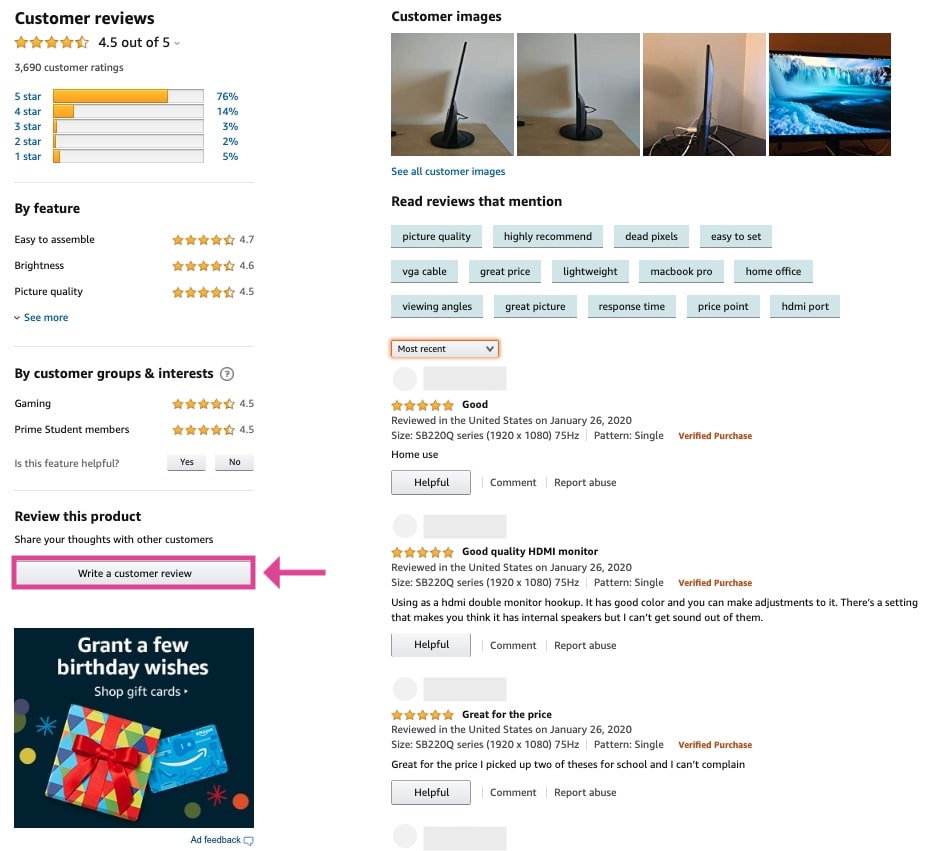
Some online retailers will additionally remind you in a follow up email to leave a review and provide a link to do so in there.
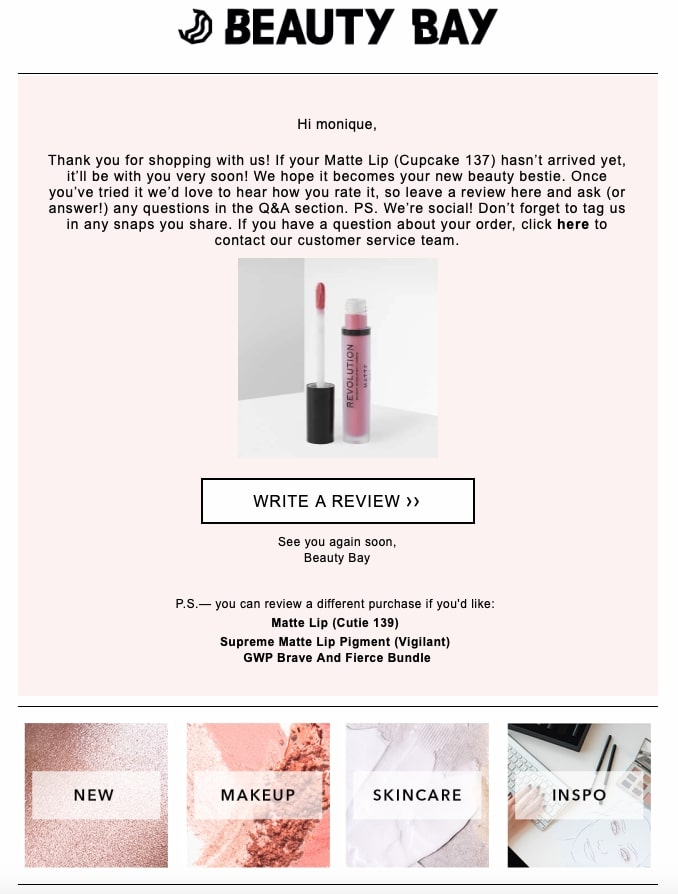
Sometimes you will also have the option to publish your review anonymously.
Leaving a review on a third party review site is more common for places and services
than for products. Different review sites have a different emphasis and target different
niches. While you predominantly find restaurant reviews on Tripadvisor and Foursquare,
you find mostly reviews for service related businesses on Angie’s List. On Amazon you
find mostly ecommerce related ratings and on Google or Yelp you can find reviews on
pretty much any business.
In general, you do need an account to leave a review on third party sites and most
online shops too. However, some retailers will let you leave a review even if you
checked out as a guest.
What you do to leave a review is a pretty straightforward process. You log in, search
for the business or product you want to review, find a button or link with a call to
action that says something like “Leave A Review” and fill out the form and submit it.
Sometimes your review will be live immediately and sometime it will be manually reviewed
first to make sure it is legit and courteously, meaning not containing any language or
spam.
When you leave a review, here are 5 tips to make it super helpful for others and more likely you get a response from the company:
- Mind the length
Too short is not good, neither is too long. You’re safe in the middle.
Be sure to include all necessary information and keep it brief enough so people won’t scroll past it. Include your experience with customer service and the product (e.g. skin serum, food at a restaurant) or service (e.g. haircut, home maintenance) itself. Also mention when you had this experience (e.g. in Christmas time). This is the kind of information reader need to paint a clear picture.
It is normal to have to wait longer for your food and that the waiters are busy when it’s 7pm on a Saturday versus 3pm on a Tuesday. It is also understandable that there are increases delivery times in the Christmas season. You can also mention details if they’re relevant like if you got the window seat or any other special treatment you asked for. Anything beyond that typically is too much information. - Don’t worry, be happy
Even if you had a really bad experience with a product or service, remind yourself that this is most likely a luxury problem. When you can afford to shop things that aren’t essential for your survival, you’re blessed. Share your experience in a factual way without being scathing, using profanity or excessive exclamation marks like this!!!!!!!!!!!!!!!!!!! Readers will ignore reviews that are apparently aggressive or passive aggressive. - Be prudent with your praise
It’s amazing when you had a divine experience and want to give well deserved kudos and share it. Just be mindful that it could come off as fake or influenced when it reads like you just put lipstick on a pig. - Honesty is the best policy
Paint the most accurate picture you can for the readers. This way you ensure that your review is helpful for people and they find what they need in your advice. -
Check your spelling
Your review doesn’t have to comply with every little orthographic rule. Just make sure that it’s well written overall and don’t be a lazy speller because your review is also a reflection of you. A review that’s grammatically correct and uses punctuation is simply more powerful than a sloppy one that’s loaded with errors. When you’re uncertain, you can always use the help of autocorrect, spell check or tools like Grammarly, or simply give it a final read before submitting.
How can I include good customer reviews in my digital marketing strategy?
Customer reviews and testimonials are a digital marketing secret weapon. Even though we
are roughly 10 years into the review economy right now,
businesses aren’t leveraging customer reviews and testimonials too much. This means you
can still be a pioneer and early adapter when you start now.
Customer reviews help you gauge your overall brand reputation and present the gigantic
opportunity to use them as a tool for your online reputation management. Check out these
6 Tips for Effective Online Reputation Management by
Adlibweb to learn more.
This is your chance to stand out as a small business and leverage good customer reviews
in your digital marketing strategy. According to the Local Consumer Review Survey 2019 by BrightLocal,
the average
consumer reads 10 reviews before feeling able to trust a business and 76% trust online
reviews as much as recommendations from family and friends.
By including customer reviews in critical places on your website or online store, you
can control the narrative and legitimize your product or service.
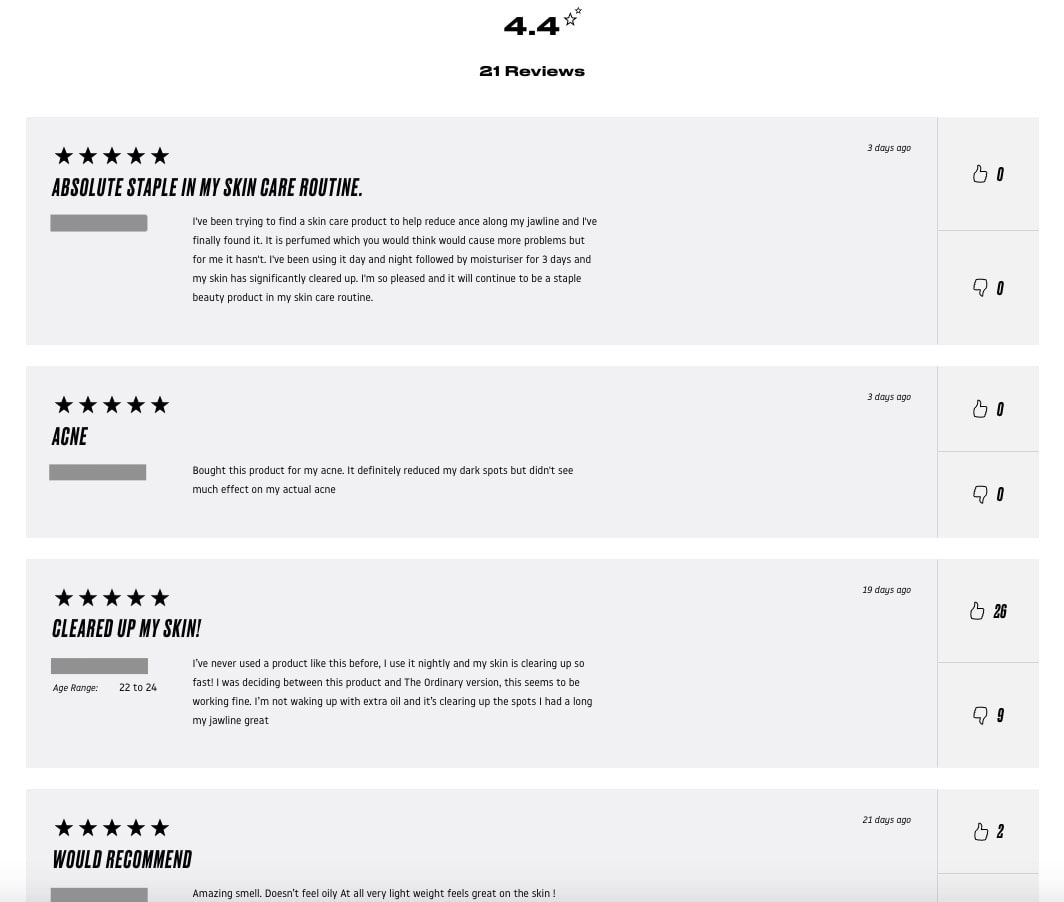
Make sure the reviews you showcase are real and verified. Although I understand that the
thought of buying reviews might be tempting as a small business, you’re only hurting
yourself and risking an image damage when you’re doing it. The consumers today are
smarter than ever and can see through it.
Real reviews also enable you to pinpoint your happiest customers. You can use this as an
opportunity to reach out to them and connect. They may be an excellent candidate for a
case study. This is your chance to build a trusting and mutually beneficial customer
relationship.
To get more reviews and find more reviews worth sharing, be present on as many mayor
review platforms as make sense for you. Here's our top 30 of the
Best Customer Review Websites.
You can learn more about how to gather more reviews
here.
You can put reviews on your home page, your product pages, your checkout page, and even
use them for upselling because they’re an “unsalesy” reminder that other people have had
a good customer experience. You can also put your reviews on various digital marketing
channels e.g. post them on social media. People already expect to see customer feedback
and insights there, so it’s natural to add more and it’s a huge audience. You can also
include them in a promotional email to get your highest praises in front of your
potential buyers’ eyes.
Social proof is such an important factor of persuasion that you will most likely speed
up your sales process by leveraging reviews as a sales tool and including them in your
digital marketing strategy. When you want to learn more about the other factors of
ethical influence and persuasion, I can really recommend you this best-selling book.
Don’t forget about your employees and colleagues. Your people are your company’s biggest
asset. They are also your best advocates. You can encourage your team to also share your
positive reviews with their own networks. In general, it’s pleasant and gratifying when
your people stand behind your company so much that they share your content and your
posts and link out to your products or services. In this post we teach you an amazing
leadership strategy that encourages your team to do so.
Finally, I’d like to mention again that you should treat negative reviews
sympathetically and reply to them too. There is a huge opportunity in negative reviews as well.
Why is responding to customer reviews important?
Collecting more reviews is a great start. Now it’s time to take it a step further and
talk about responding to your reviews. This is a vital next step in your digital
marketing strategy. Responding to your customer reviews fosters trust with your
customers.
A heartfelt, well-written response makes your brand more human and means so much more to
your customer than just a like or a share. All you need to do is invest a little bit of
time in it. Customer experience and customer relationship are so vitally important and
you can create a superior one for free by just investing a few hours a week. You can
also harvest the results pretty quickly, compared to other digital marketing efforts.
In general, it is important to respond to the positive as well as the negative reviews.
By responding to your reviews you improve customer relations and the experience for your
customers. A great customer relationship benefits your business on every level.
You can gain insights from positive reviews and use the interaction as a tool to build a
better customer relationship. By replying to your positive reviews you can start a
conversation with your customers and learn more about them and allow them to be
advocates for your business.
You can gain insights from neutral or negative reviews as well. Use them as an
opportunity to develop yourself and learn. There is nothing either good or bad but
thinking makes it so. Look at it from another angle and see the criticism an
opportunity. You can engage in a conversation with your unsatisfied customers and use
the feedback to optimize your customer journey. If there was a mistake on your side,
admit it quickly and emphatically and offer to make amends for the discomfort to prevent
customer churn.
See more benefits of customer reviews here.
You should start every response by greeting the customer with his or her name and
thanking them for taking the time to review you, no matter if the review was good or
bad.
Here are my top 3 tips how to respond to customer reviews:
- Respond quickly
You want to respond shortly after your customer left you a review. You shouldn’t take any longer than 1 week to reply to a review. That way customers feel valued and they know that their feedback is important to you and you prioritize it. - Pick the right person
Depending on the review and context you might want to have someone with a higher rank in your company reply to the review. A response from an executive or owner will likely mean more to a reviewer than a response from an entry-level employee. Leave an appropriate impression wherever suitable and don’t always have the same person reply. - React to the details
Many companies have a standard reply that they reply to every review with. Most of the time it just goes like “Thank you for your feedback.” or “Hi [first name], thanks for your review.” 🤭😴 Boring.
Of course you should say thank you and let your customer know you appreciate it. Then take it a step further and stand out from the crowd. Take an extra minute and be responsive to the details mentioned in the review, repeat them, and initiate a conversation you can gain insights from. Your customer will love this and feel important and empowered. It also shows that you take action from the feedback.
Here are 6 more tips how to respond to customer reviews:
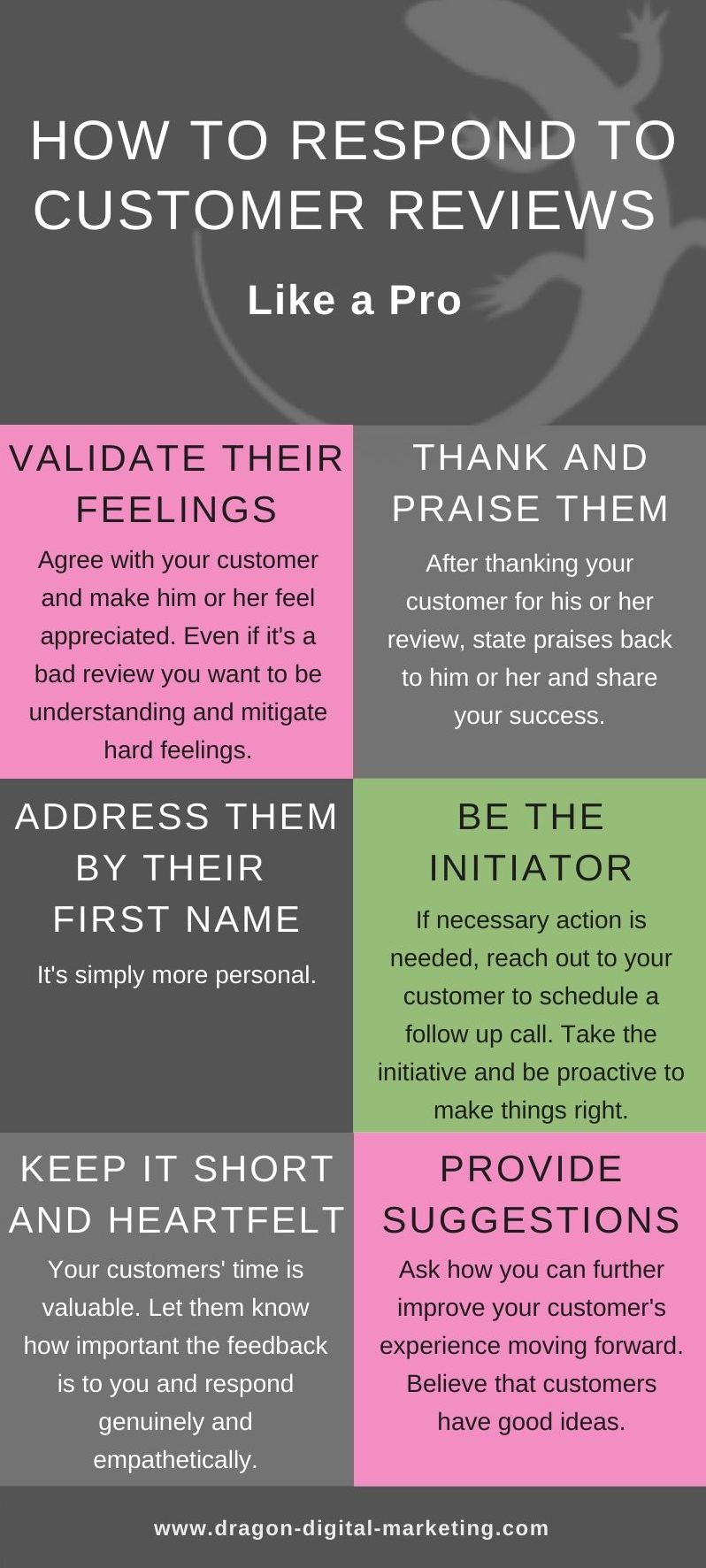
What are customer review sites I can focus collecting reviews on?
Submit your website to the major business directories and review sites t be able to get
as many reviews as you can. You can submit your business to several business directories
at the same time using the paid services of Moz local or Yext.
When you'd rather do it yourself and not have ongoing expenses for this, make sure to
consider our list of directories that we think are especially relevant.
Here's our Top 30 of the Best Customer Review Sites:
- Twitter
B2B & B2C International Free
You can mark Tweets as favorite that can serve you as reviews and then embed them or screenshot them and use them wherever you want. Tweets with positive feedback about your products or services serve as social proof and improve your conversion rate.
Twitter also indexes Tweets in the Twitter search results which means that it’d be worthwhile to start a hashtag for reviews and feedback. It also means that your reviews show up when someone searches for reviews of your business on Twitter and the query has the right keywords.
Moreover, I think Twitter is the second best platform for social media marketing right after Facebook (and here's why). - Google Search and Google Maps through Google My
Business
B2B & B2C International Free
Claiming your small business in Google My Business makes it appear in a special search result in Google Search. Businesses that have a Google My Business account also get listed in Google Maps. Customers are able to leave you a review on both platforms.
You can give your business a boost by uploading pictures and videos of your location and also show people how you and your team work behind the scenes. You should also publish posts and tell people about what’s new and your latest offers regularly. The more active you are and the more people engage with your business profile, the more often it is shown in Search because Google thinks it’s more relevant then. The Google algorithm also counts other factors in like proximity and automatically shows it to people it’s the most relevant for. - Apple
Maps
B2B & B2C International Free
Apple has over a billion users and the highest website authority there is. People who find your business profile on Apple Maps can see your Yelp reviews and also get directed to Yelp to leave you a review. - Bing Places For Business
B2B & B2C International Free
Bing Places For Business is Microsoft's counterpart of Google My Business. You can even import your Google My Business profile so you don't have to enter all your info again. This makes signing up even more convenient and it's just as powerful as its Google companion. It shows the reviews from Yelp. - Yelp
B2C International Free
Yelp is a business directory and a crowd sourced review forum. It helps you to get found easier by potential customers and also allows customers to leave you online reviews. - Better Business Bureau
B2B & B2C USA, CAN, MEX Paid
BBB is a highly reputable business directory and has built a community and a market place of trust. This is why it's not free to become accredited here. Being able to put their badge on your site gives you credibility and you can also get reviews.
They evaluate every business against a set of best practices and when you meet the accreditation standards, you can become accredited. Unlike most directories, where you get rated 1-5 stars, BBB rates businesses from A-F. - Amazon
B2C International Free
Amazon was one of the first online stores to feature reviews and has had that functionality since 1995. It has established itself as one of the most important resources where consumers look up information to make more informed buying decisions. People would even look up the reviews on Amazon, if they don’t intend to buy the product from there. - Facebook
B2B & B2C International Free
Users can review places and businesses directly on their Facebook page. The ratings are displayed in a tile in the right column of a Facebook business page. Facebook is also the best platform for social media marketing. - Your own website
B2B & B2C International Free
Don’t forget about your own website.
It gives you the huge advantage of having full control. You can embed some Tweets and other reviews or create a whole reviews and testimonials section. You can also create a form where your visitors can write you a review right then and there. It’s simple and obvious and there’s no account on third party platform needed. - Foursquare
B2B & B2C International Free
A Foursquare listing will also help you to attract more customers. Foursquare recommends places to people based on their personal preferences. It is a city guide and you can get reviews there too. - Yellow
Pages
B2B & B2C International Free
You probably already know about the Yellow Pages telephone and business directory since it's the most prominent one. Make sure to be listed in there and collect customer reviews. - Angie's List
B2B & B2C USA Free
Angie's list has been around since 1995 and has developed itself to a renowned directory for local service providing businesses. You definitely want to leverage this platform for reviews if you're in the US.
You can get reviews on an A–F scale and only members can write reviews. This means that the reviews typically well-thought out and there’s not much of ranting and raving or fake reviews. - Yahoo
B2C International Free
Yahoo is the 3rd most used search engine in the world after Google and Bing.
You can only get your business listed in Yahoo by signing up via Yext. Don't worry though. There is still a way you can get it for free, in case you're not interested in a paid plan. The site is set up a bit tricky so we got the following tips for you.- Go to Yext, enter your info and click "Scan my listings"
- Ignore the page scan results page showing you all those errors that make you think there's all sorts of things wrong and just click "Continue"
- Update your information on the next page and click "Continue" again
- Now it looks like the only thing you can do is pick one of the paid plans
- Scroll down and click on the itty bitty link saying "Claim your basic listing only on Yahoo"
- Voila! Your checkout price is $0
- Hotfrog
B2B & B2C International Free
Hotfrog is another online business directory and it allows you to add detailed information about your business. You can add more info than in most other directories, like keywords, testimonials, special offers, and even documents, and leverage it for online reviews. - Choice
Reviews
B2C AUS Paid
Choice is an Australian review site that tests products and services independently and then provides reviews on the performance to the members. You can also find product comparisons and buying guides on there.
They also allow members to review certain products and brands and engage in a discussion with fellow members. If you do business in Australia and have Aussie customers, this is something worthwhile to look into. - Trustpilot
B2C International Free
On Trustpilot customers can write seller and product reviews. The free version allows you collect customer reviews on your business profile page. The paid version additionally allows you to create custom review invitations, share your reviews on social media, and embed them on your website. - TestFreaks
B2C International Free
TestFreaks helps you collect online customer reviews and write seller reviews to complement them. There’s also a Q&A feature where your customer service team can answer your prospect’s and customer’s questions. - Which?
B2C UK Paid
On Which? the organization itself as well as the voting members can assess products and services.
If you do business in the UK and have customers there, it’s worthwhile checking out and the fact that you have less influence on whether or not your are on this review site, makes it more credible.
If you want to let Which? know about your products and services, you can send an email to [email protected]. - ConsumerReports
B2C International Paid
ConsumerReports is a nonprofit that accepts no advertising and pays for all the products it tests. They publish high-quality super helpful and well structured content and are transparent about their review criteria. Your product better be really good, if you want a good review from ConsumerReports. - Tripadvisor
B2C International Free
Tripadvisor is best known as the place you can find reviews of restaurants, hotels, airlines and travel related stuff, as well as entertainment. It is the largest travel review site in the world and a lot of people have a look at Tripadvisor reviews before making their trip.
They have a ranking algorithm where only the most popular businesses make it to the top and can be seen. The 3 main ranking factors are the quantity, quality, and recency of your reviews. - Influenster
B2C International Free
On Influenster you can find over 40 million product reviews from influencers. If you want to get into influencer marketing as well, it’s a great place where you can find micro-influencers with a small but loyal following. You can find someone who covers your niche and is also more affordable than the big ones with millions of followers.
The reviews on this review site are more beauty related because that’s the sector influencers typically operate in. - FinancesOnline
B2B International Free
FinancesOnline is one of the fastest growing review sites and online business directories for B2B and SaaS companies. It got over 2.5 million visitors a month, over 8,000 detailed reviews and over 11,000 real user reviews.
In addition to user reviews, they include their own review, answering the most important questions, as well as pricing details, alternatives, and integrations. FinancesOnline pages tend to rank high in Google too. - G2
Crowd
B2B International Free
If you’re a SaaS company, you need to be on G2 Crowd. G2 helps people discover, buy, and manage the technology they need to reach their potential and they have over 1.4 million visitors a month. - TrustRadius
B2B International Free
TrustRadius is a website for software reviews and software comparisons. Every reviewer on TrustRadius is verified and they don’t have ads and are unbiased. In addition to reviews they also have buyer guides and TrustMaps. - GoodFirms
B2B International Free
GoodFirms is a review site for software and services. You can also find video reviews here and get basic information like the hourly rate of a business and number of employees. The most important performance factors for the score are the quality, reliability, and ability. - Salesforce AppExchange
B2B International Free
If you sell an app on Salesforce AppExchange, you want to keep track of your reviews in this cloud computing store. - Glassdoor
B2B & B2C International Free
Glassdoor is a review site for companies that job seekers can use to get information about a company. Employees and former employees can say how they feel about a company and share their pros and cons. You can find tips for an interview there and read about what a company really is like from the inside.
You can use it to build your employment brand and to attract candidates or just use your reviews to gain insights and improve as a company. - Manta
B2B & B2C USA Free
Manta is an online review site for small businesses and is focused more on connecting people. - Capterra
B2B & B2C International Free
Capterra is a review site for software reviews. Users can compare up to 4 different softwares with each other there and find what’s best for their needs. If you’re a SaaS business, you should look into Capterra. - HundredX
B2B & B2C International Paid
HundredX is a review site and a customer service tool. You can sign up for an account and ask your customers to leave you feedback. HundredX provides you with the survey tools and you no longer have to manually scan the internet to get an overview of what your customers think and feel. You can use the surveys in a variety of ways in all kinds of different channels.
Your reviews are only visible to you in your HundredX profile and not shown on their site. If you get a negative review with HundredX, you have a chance to fix it and make it right without it impacting the buying decisions of your prospects.
I am learning a lot from ur content.
— theduu - Digital marketing partner (@DigitalDairy) February 15, 2020
Hi Monique,
— BestReviewWarrior (@BestReviewWarr) February 9, 2020
Has anyone ever told you how robust your content here is?!
I believe people have paid an arm and a leg for the information you give here, free.
Thanks for sharing! pic.twitter.com/NKcNiFyzAR


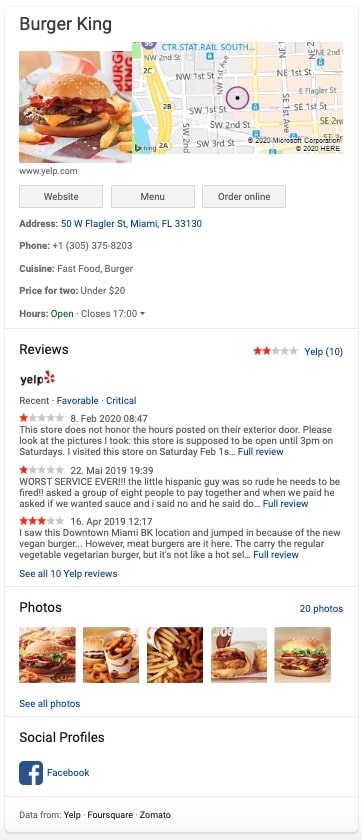

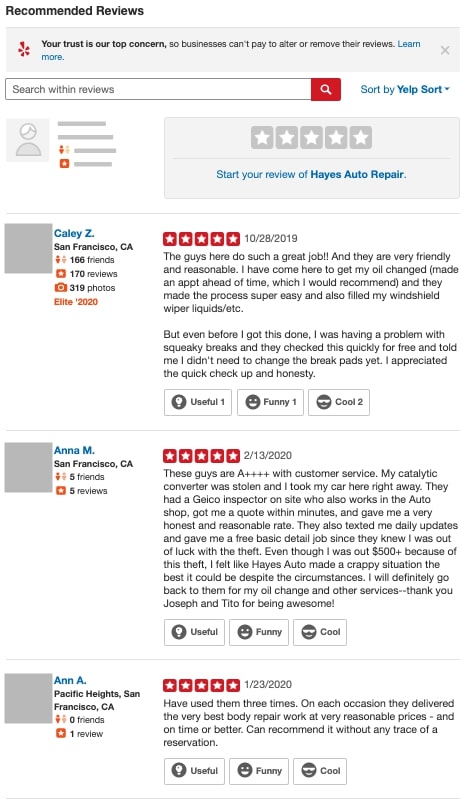

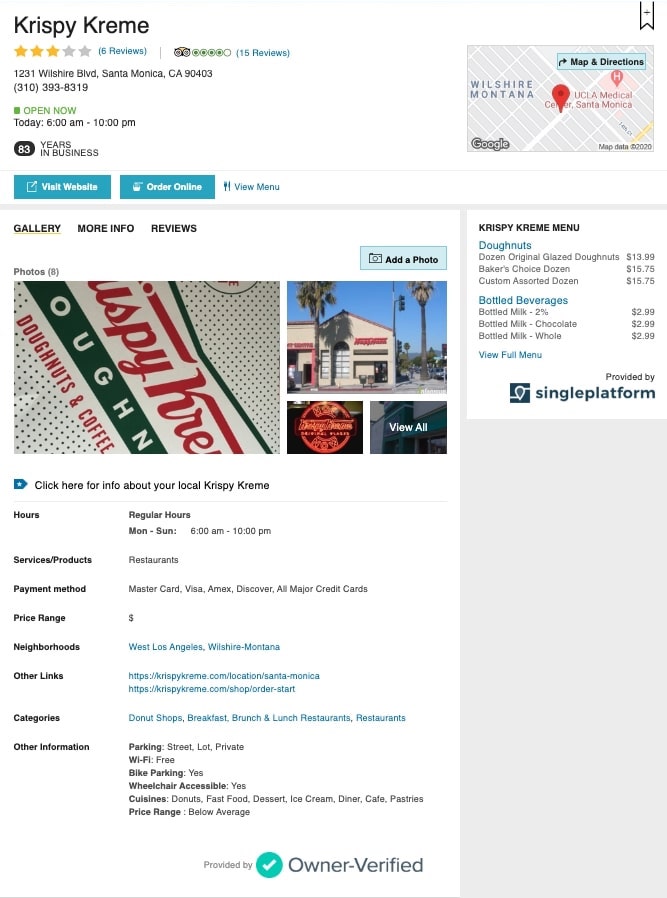

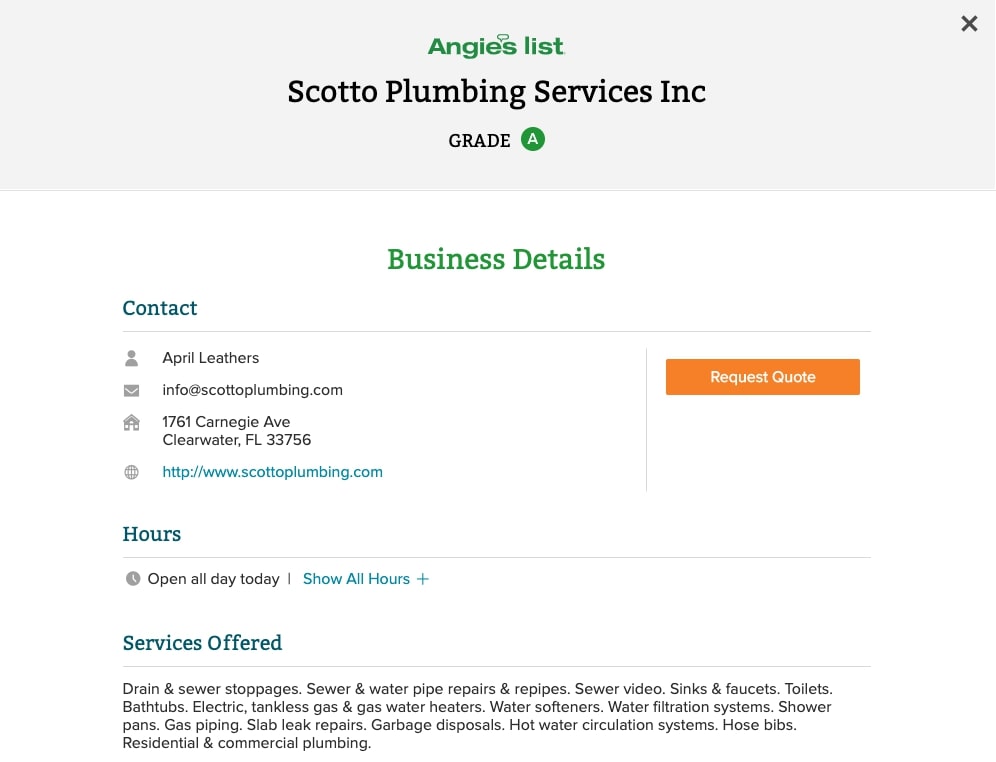
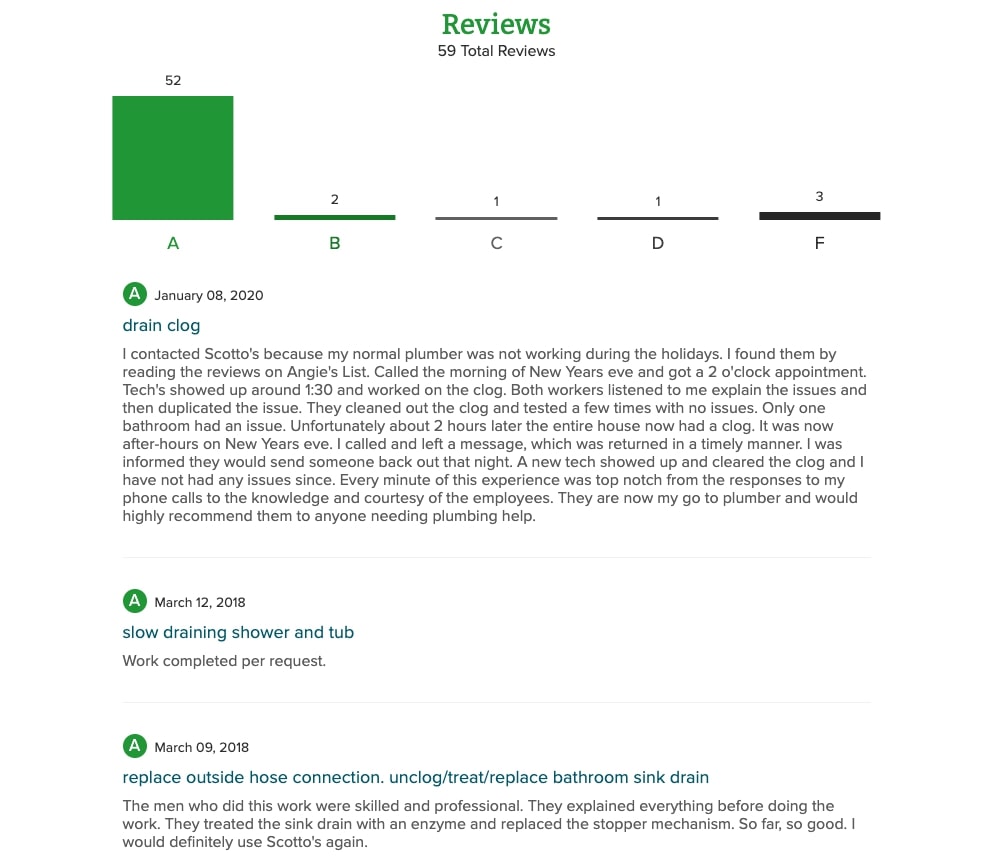
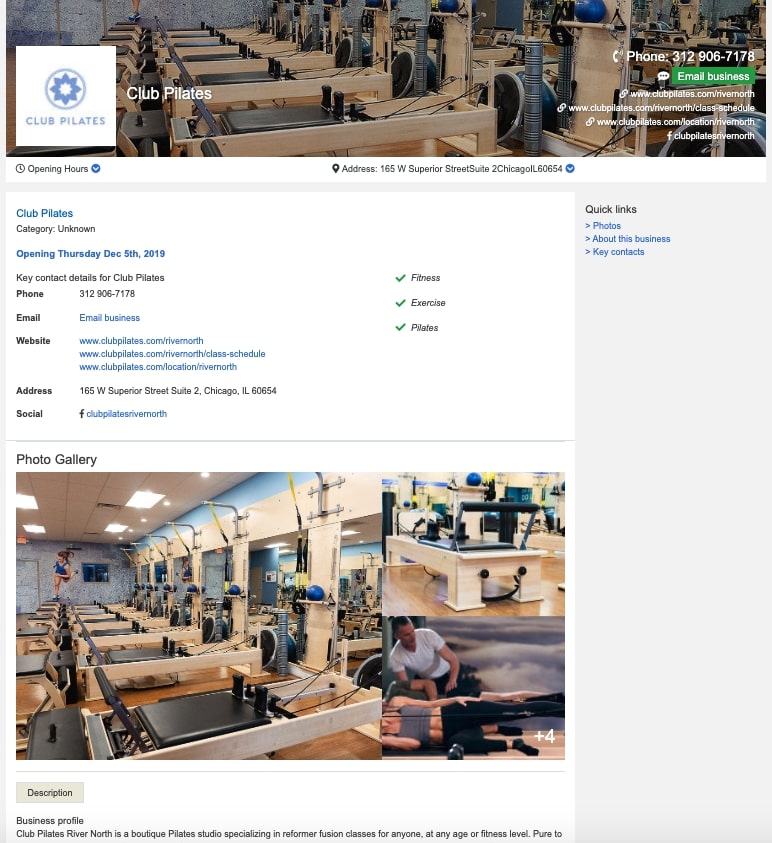
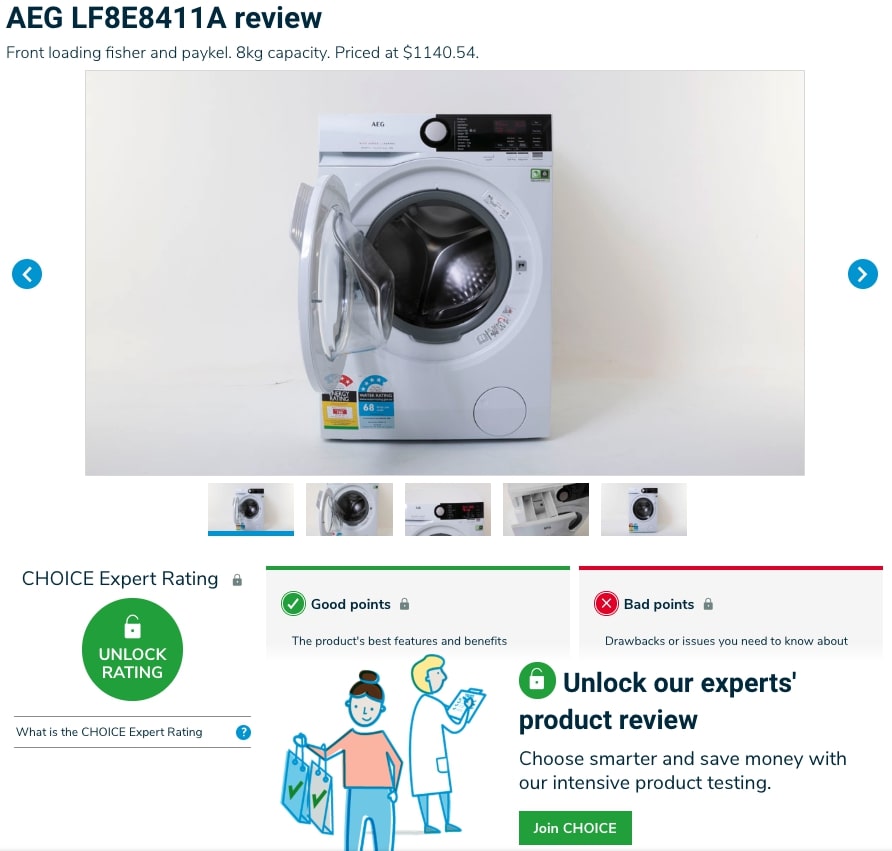
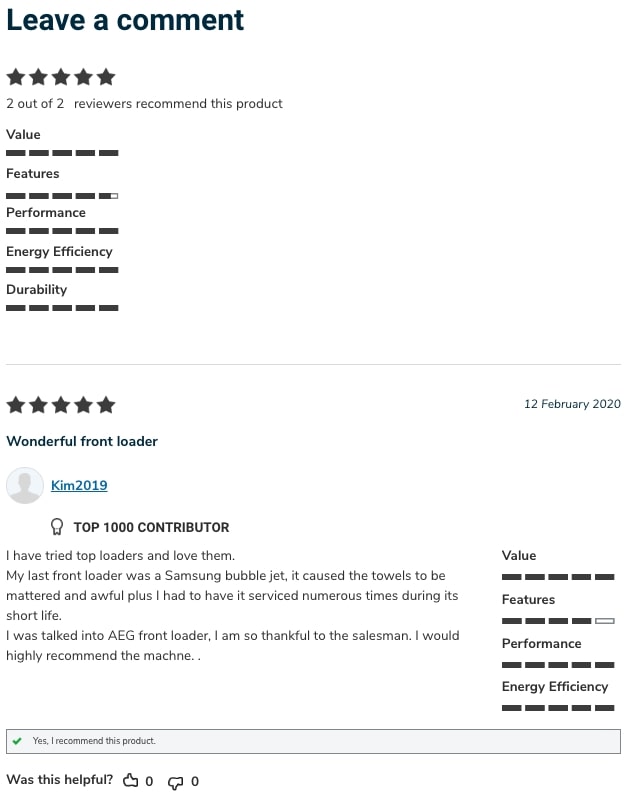

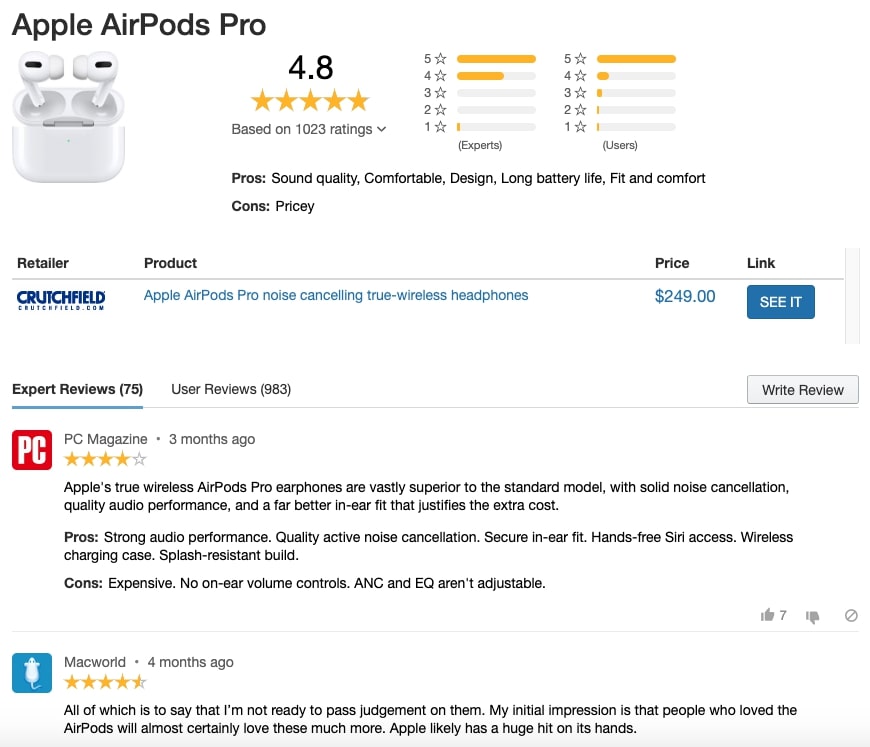
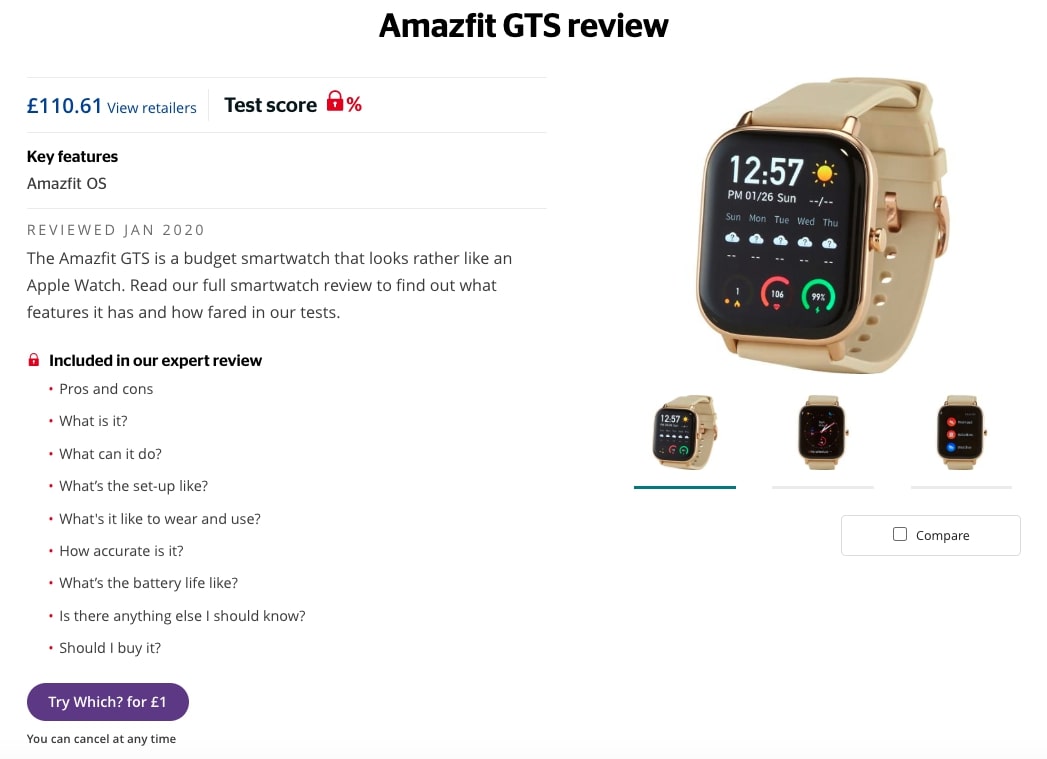
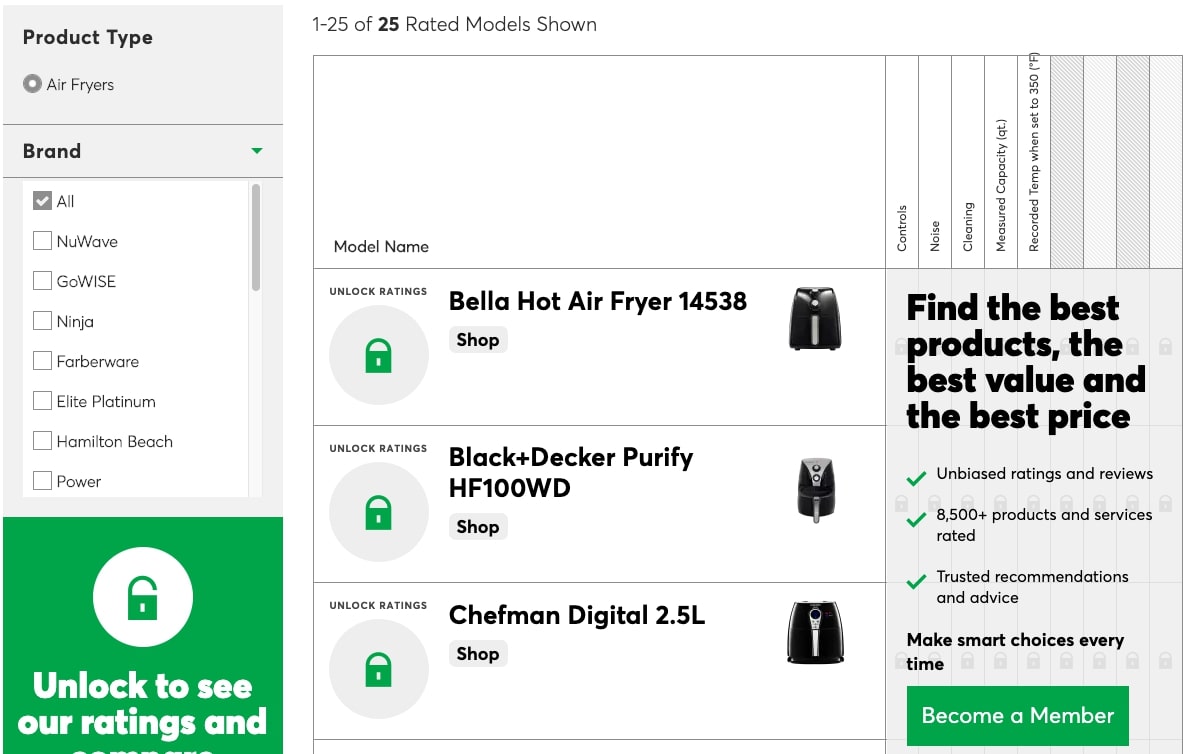
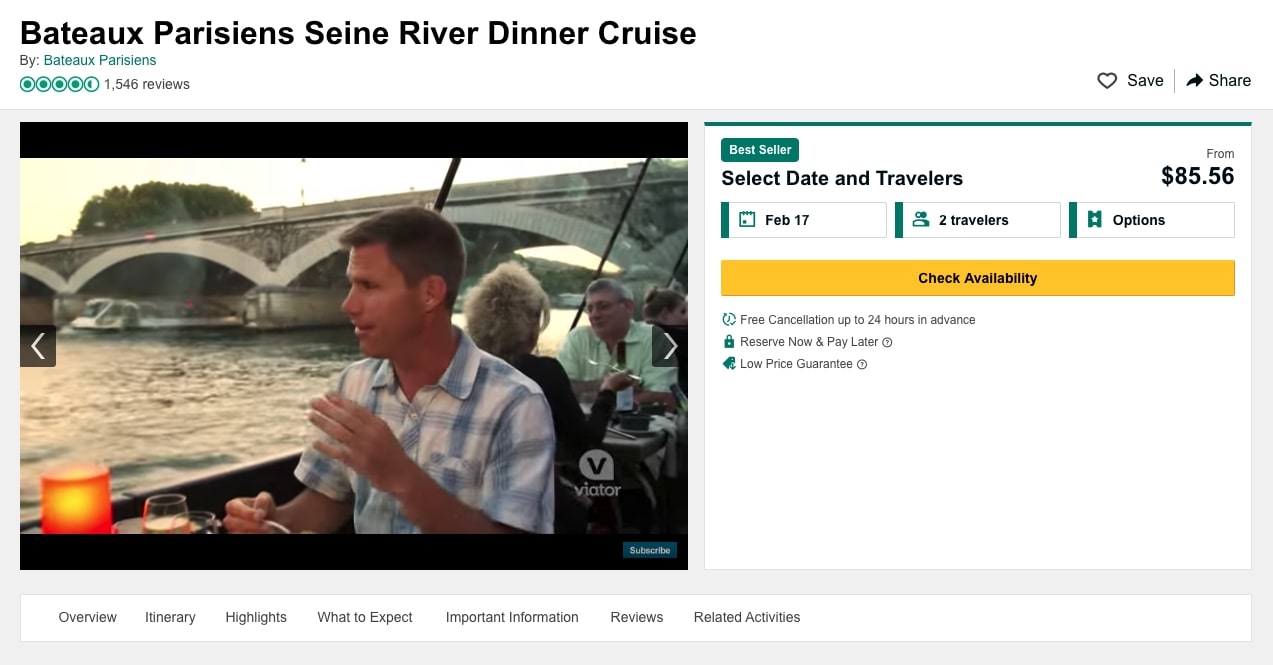
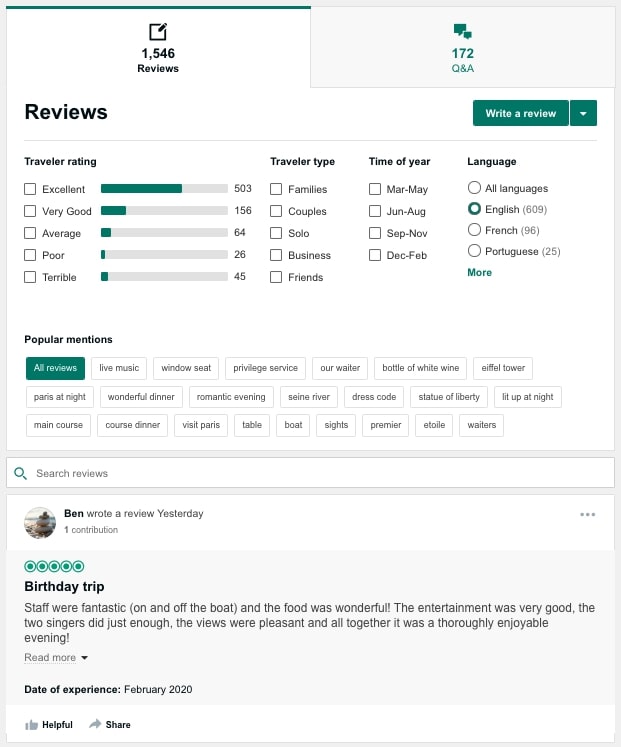
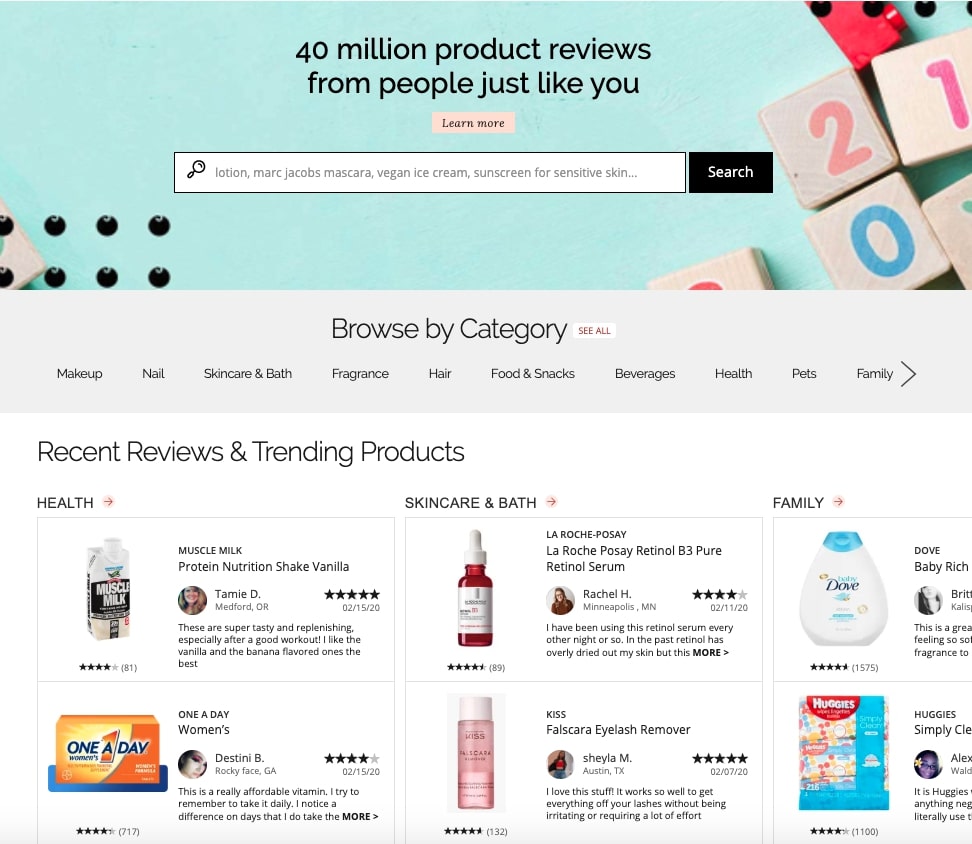
ActiveCampaign is the email marketing and marketing automation software that we use ourselves. It's the CRM tool of our choice because it does a great job at connecting marketing and sales processes, increases the conversion rate, revenue and traffic, as well as the engagement with and deliverability of marketing emails. You can use it to send out emails in bulk and ask your customers for reviews and then track the interaction and automate a followup, for example. As a partner agency of ActiveCampaign we earn a commission when you decide to turn your leads into repeat customers using this link.
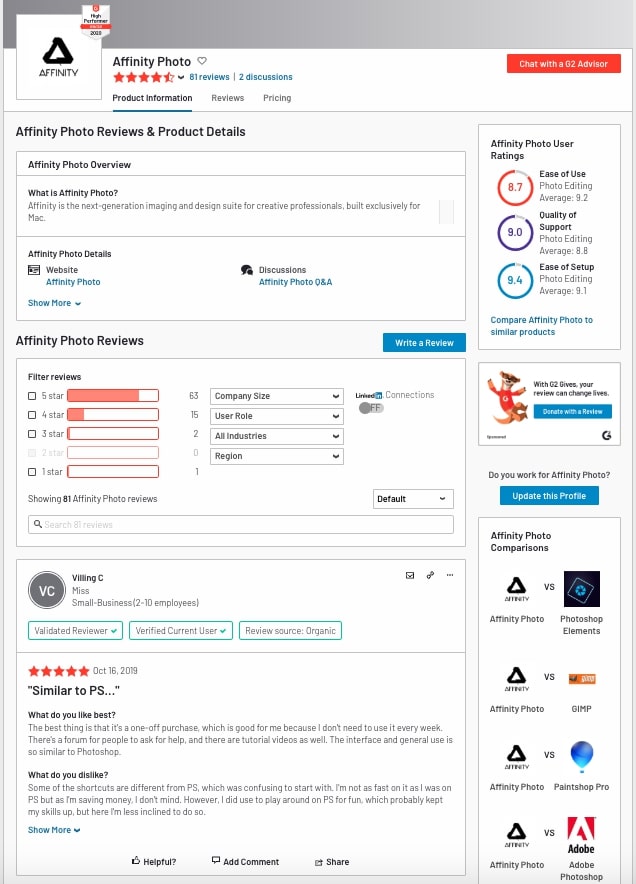
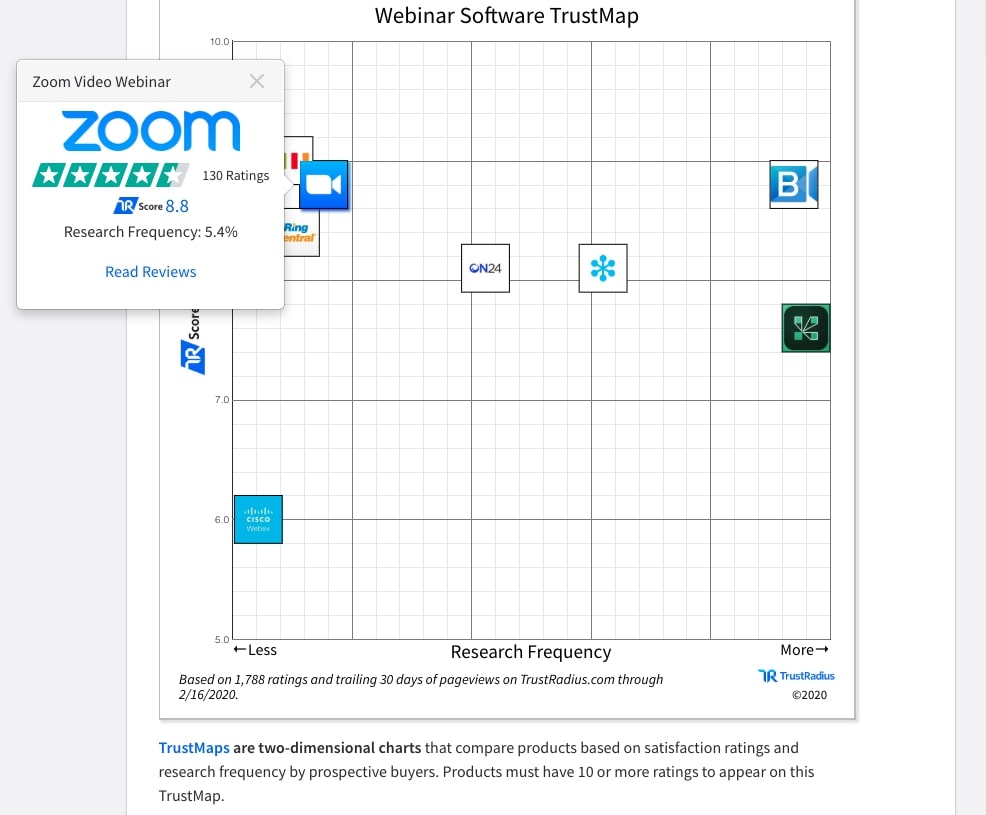
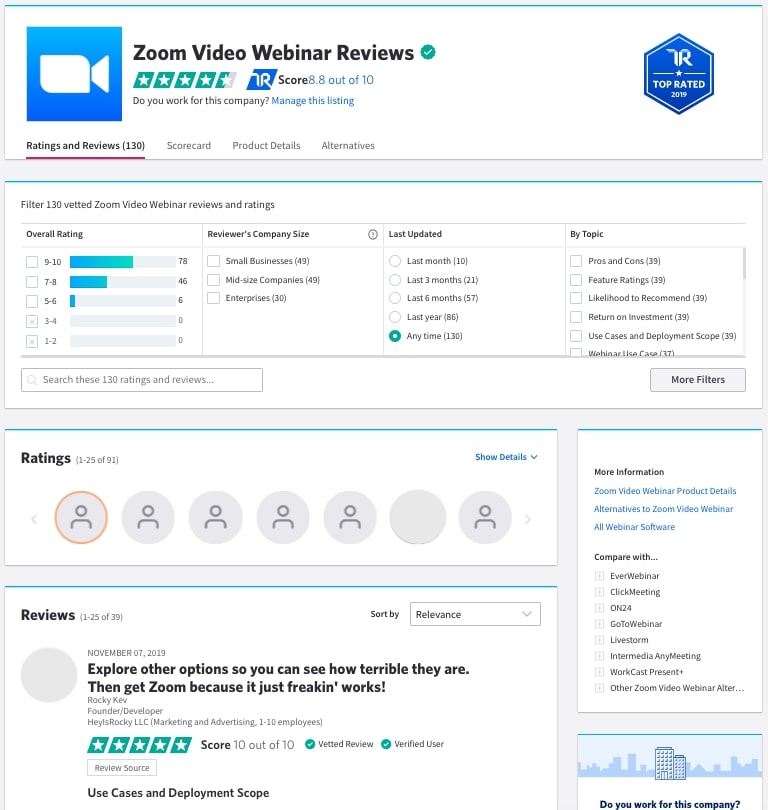
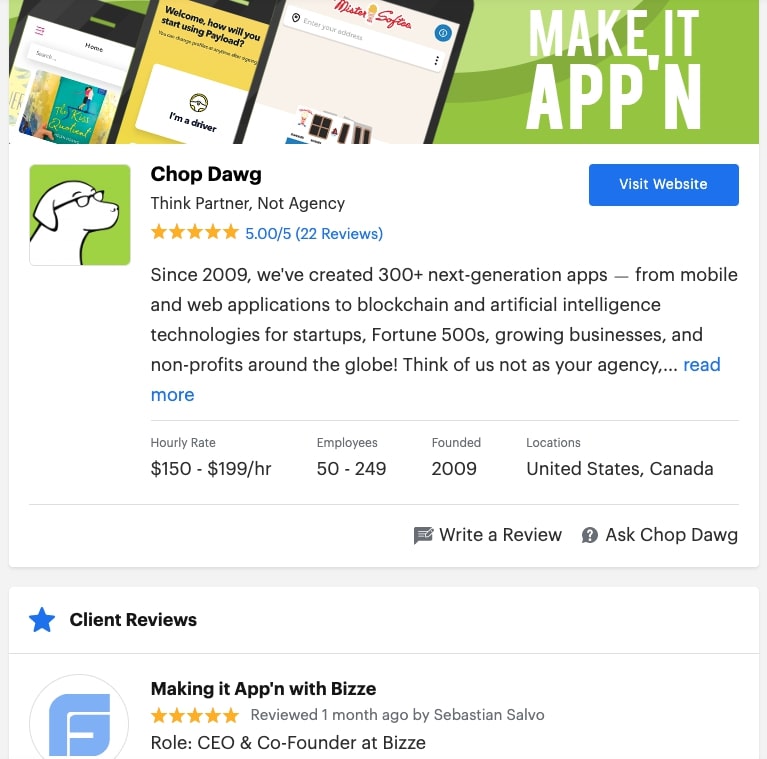
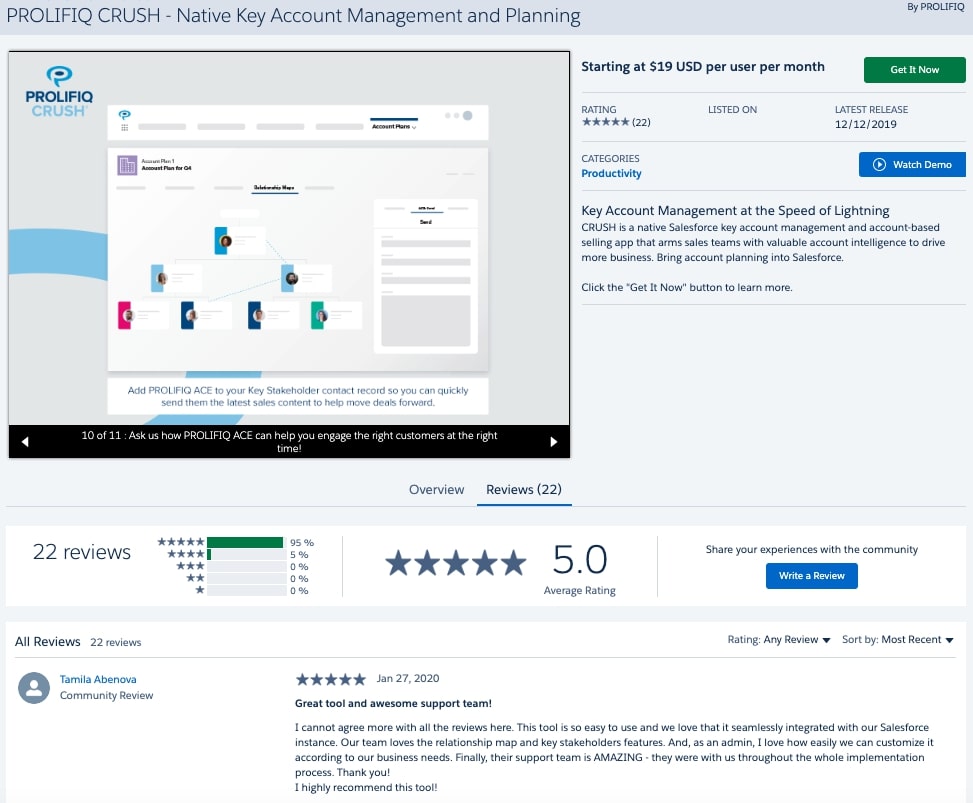
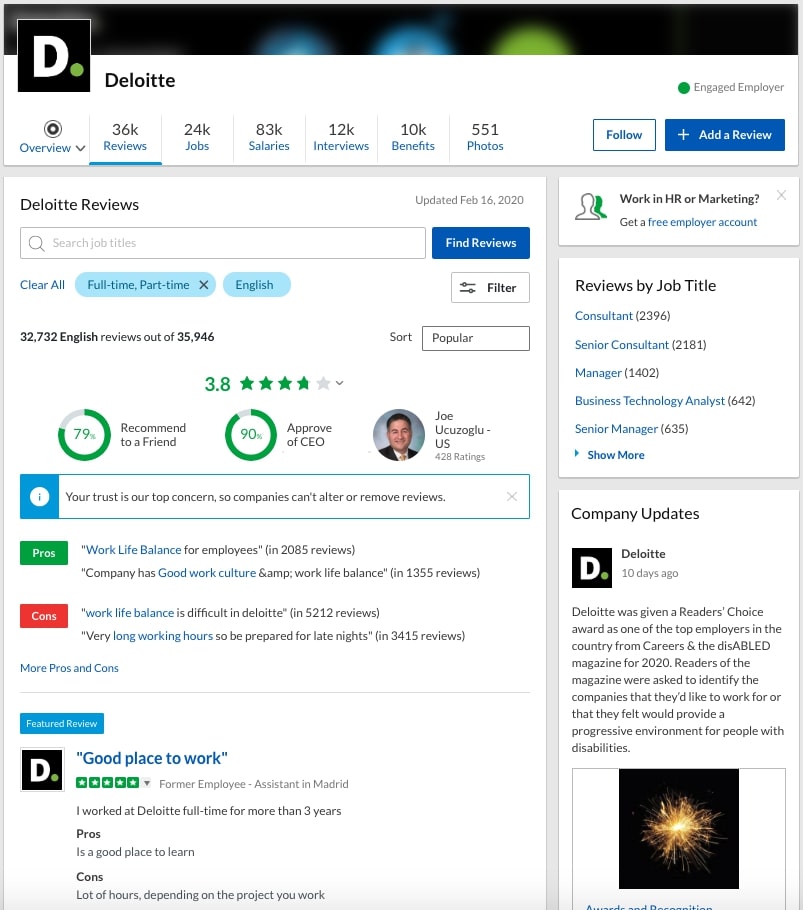

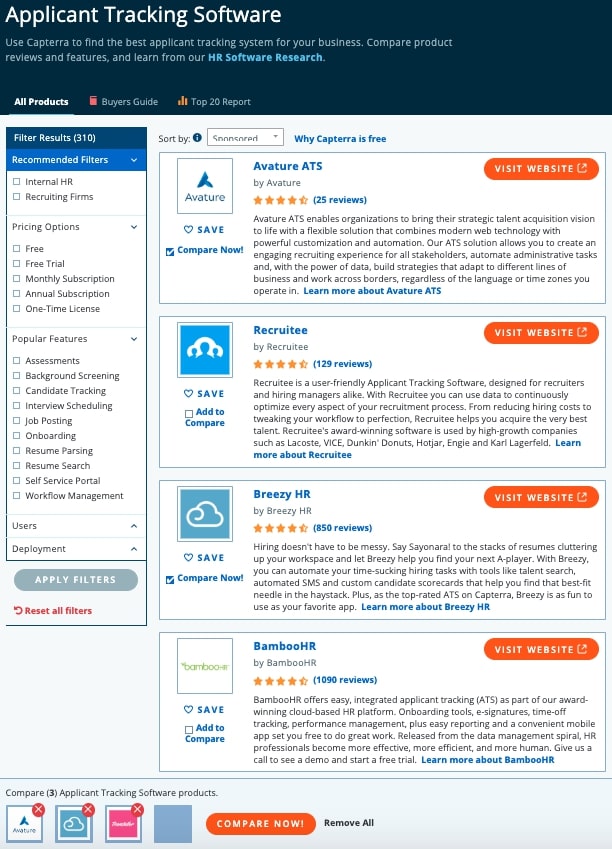
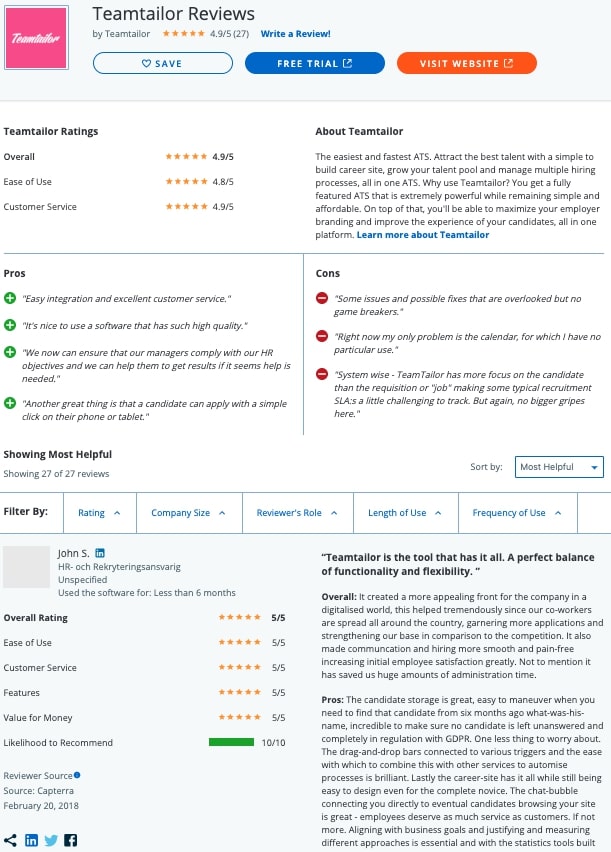
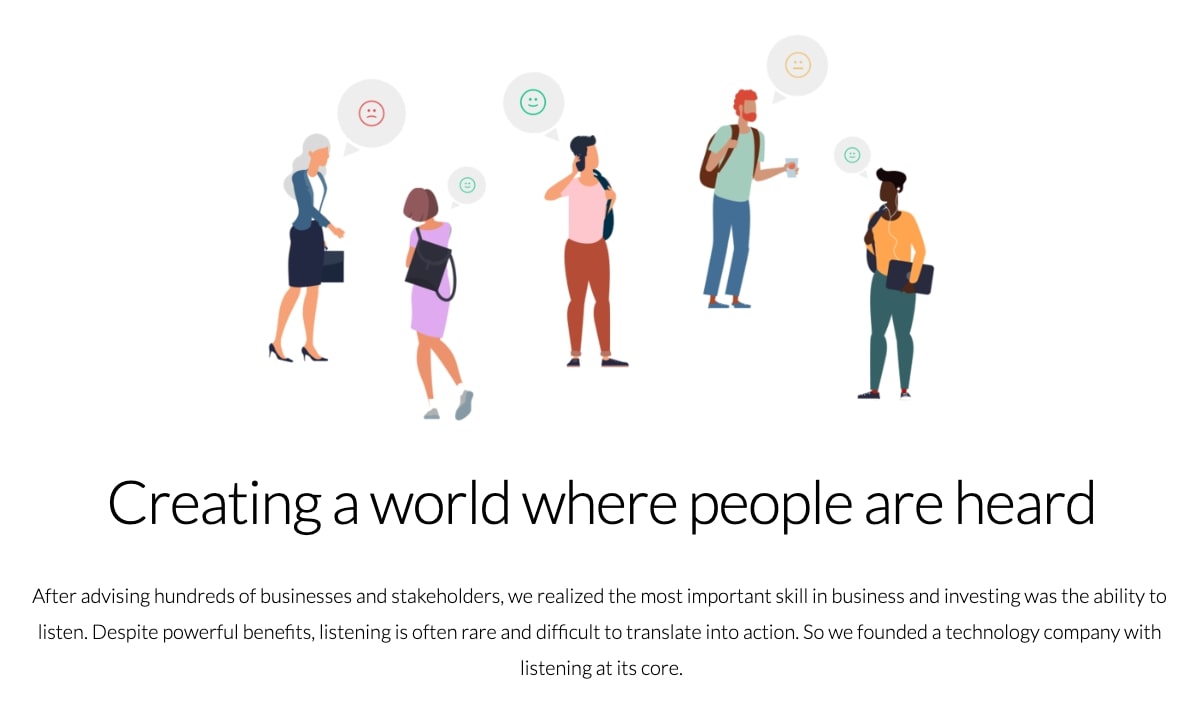
Google My Business (GMB)
What’s the first thing you do when you want to know about something? That’s right, you
Google it. Me too. Almost everybody does it. That’s why Google My Business is the most popular platform and the place to be for every
business.
If you haven’t already, go ahead and create a Goggle My Business profile now. If you already have one, make sure it’s complete and you really have
every area of your GMB profile filled out.
Save your personal review URL, so you can easily share the link with customers. Because it's a pretty long link, you can optionally use
link shortening services like TinyURL, Rebrandly, or Bitly and create a
shorter URL for that long link. This way you can
brand it, share it virtually everywhere, and track the clicks its getting.
A Google My Business profile also allows you to be seen on Google
Maps. And it allows people to ask questions about your small business. If you want to be seen as a
trustworthy expert, we highly recommend using this feature and answering your potential new customers' questions.
Google My Business is an incredibly important tool for every business seeking an online presence.
How can I ask for a customer review?
You need to encourage customers to review your business and make it as easy for them as
possible to leave you a good review. No long and complicated codes they have to enter,
no long forms to fill out, etc.
Make your customer service so remarkable that people can’t help but leave you a good
review because they are so amazed about the great experience they had at your place.
If you’re a local business, remember that reviews and mentions are the backlinks of
local SEO. That means they’re even more important for you.
Include links to your Google My Business account wherever you can, prompt your visitors
to leave you a review on your website, on your social media profiles, on flyers and
business cards, in your email signature, etc. Create every opportunity possible for
customers to leave review.
When you’ve created all those opportunities for your customers to leave you reviews, you
took the first step. The next step is to actively ask your customers to leave you a
review because a lot of people are more than happy to review you when you ask them but
wouldn’t do it on there own. You don’t want to miss out on them.
Here are 4 ways you can ask your customers for reviews:
- Watch for a favorable opportunity
Chances are that you will have the favorable opportunity to bring it up naturally in a conversation, when you watch out for the right moment.
When you’re talking to someone about your product or service, ask how they feel about it, then ask them to write you a review.
If you feel like you’re asking too much in that situation, use this technique. Ask for something that is obviously over the top, then when they say no, ask them for leaving you a review. Leaving you a review sounds like the least they can do after turning down your other huge request. - Make it your standard response to praise
Bide your time until someone praises your product or service and tells you how much they love it. Any positive mention about a purchase from you or the experience they had with you is what you need to train your mind to watch out for.
This can be in your local store or online store, on the phone, in a chat, in an email, or wherever. Your initial thought and reply has to be to ask them to leave you a review and thus help others out. - Leverage your email list
You can ask your subscribers for their honest feedback in your next newsletter email. It is flattering to people when someone asks their opinion about something and thinks what they think is important. Make sure to provide them with easy-to-follow directions and include a link. - Ask in a post purchase follow up
You want to ask your customers for feedback directly after they made a purchase. This can be on your Thank You page for example. Ideally you have an email automation set up that reminds your customers to leave a review again after a couple of days. Additionally, you can prompt your customers to leave you a review at the bottom of the receipt.
Conclusion
Customer reviews act as the personal recommendations from friends and family. Prospects
rely on what other people have to say about a company because people buy from someone
they know, like and trust.
Customer reviews are key to understanding why people buy from you. You can gain
important insights about your customers’ point of view about their customer experience
and your buyers journey.
Customer reviews offer you the opportunity to improve your customer relationship by
interacting with your customers in a conversation. They are also a powerful sales tool
you can use throughout your buyers journey to persuade prospects with social proof.
That’s why it’s advantageous for you to collect as many reviews and as much feedback as
you can. Make sure your reviews are all authentic and real and from verified and honest
people. That way you get more accurate results from analyzing your reviews to measure
your customer satisfaction and improve your customer relations.
A great customer relationship benefits your business at every step. Reinforce positive
reviews and also answer negative reviews empathetically with the goal of understanding
your customer’s perspective and taking away how you can improve your processes and
maintain a jubilant customer relationship.
Reviews are a powerful tool and you should include them in your digital marketing
strategy. Are you strategically collecting customer reviews and use them as content and social proof yet?
Activate Your Entire Customer Experience
Try ActiveCampaign – The #1 Automation Platform – For Small Businesses
 Try ActiveCampaign Today For Free
Try ActiveCampaign Today For Free


